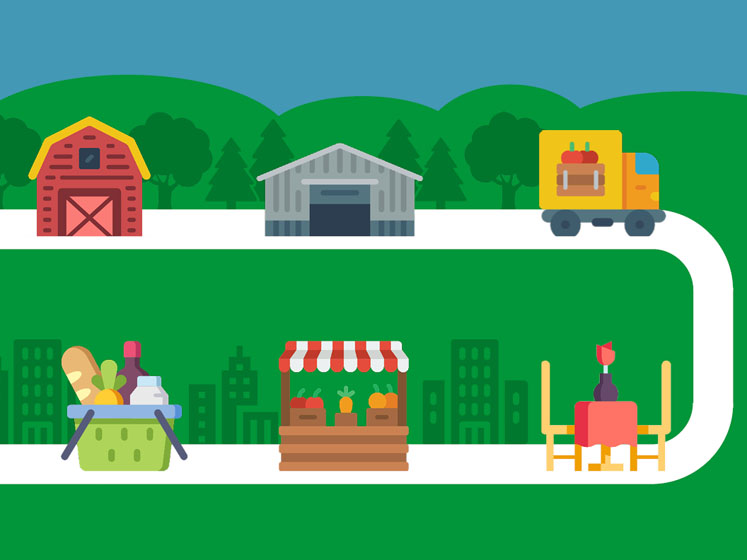So, what would compulsory traceability mean? How might traceability record keeping and, in particular, batch-level coding, play a crucial role in the swift and accurate withdrawal of unsafe food?
Adem Kulauzovic, Director of Automation, Domino Printing Sciences (pictured), explores these questions and highlights why food and beverage manufacturers should adopt traceability solutions today to protect their consumers, brand image and bottom line.
Understanding the impact of food safety incidents
The last decade has seen a marked increase in regulatory traceability requirements aimed at protecting consumers. Item-level serialisation for patient safety is now a regulatory requirement in many industries, including medical devices, pharmaceuticals, and tobacco products.
As global focus on consumer health and safety increases, manufacturers in all sectors should prepare for further regulations necessitating item- and batch-level traceability.
The food industry, in particular, is a prime candidate for regulation. Consumer safety is one of the driving forces behind product traceability, with the need to recall products from sale quickly and accurately following a food safety incident.
Incidents necessitating recalls could include the presence of undeclared allergens or additives in packaged foodstuffs or contamination of raw produce.
Product traceability via coding and marking can provide a method for keeping track of food in the supply chain to support the quick and efficient recall of affected products when required.
If a situation necessitates a product recall, growers, processors and manufacturers can utilise product codes to identify which products or batches have been affected and track where items have been sent. This helps to limit the scope of a recall, minimises waste and reduces the time it takes to resolve the issue without compromising consumer safety.
Without traceability records, food safety incidents may necessitate nationwide recalls ensuring that all affected products are withdrawn from sale. Such was the case in the US in 2018 with an outbreak of E. coli linked to the sale of romaine lettuce.

At the time, US FDA attempts to trace the source of the E. coli outbreak were hampered by poor traceability records, leading to nationwide recalls. The repercussions from the recall were far-reaching, affecting supermarkets, hospitality venues and food manufacturers handling romaine lettuce for further processing into packaged goods.
Indeed, a 2021 report on the economic impact of the E. coli outbreak estimated that the total cost of pulling all harvested romaine from the supply chain was approximately $20.6 million, with additional costs of $37.3 million from wasted stock that could not be harvested or sold.1
Food recalls can also cause serious harm to a brand’s image, leading to lost sales long after a food safety incident has passed. The indirect impacts of the romaine lettuce recall are an example of the damage that may be incurred at a brand level. Many hospitality venues and packaged goods providers found themselves unable to provide their standard products, leading to an inevitable loss of custom.
Batch-level traceability for food and beverage
The prospect of implementing additional manufacturing processes to enable traceability might sound costly. Indeed, item-level serialisation, such as that required in the pharmaceutical sector in many countries, has come at a high cost to businesses, but not all traceability measures have to cost the Earth.
For low-value, high-yield food products, including fresh fruit and vegetables, traceability can be facilitated at the batch level using unique labels on cases and pallets. This batch-level labelling provides a chain of custody, trackable forwards to the exact retailer or food processor receiving a shipment and back to the field where the produce was grown – and at all the steps in between.
In a food safety incident, batch-level traceability allows farms to precisely identify which suppliers have received their stock. It also enables retailers and processors to determine from where a compromised product may have come.
The batch-level traceability requirements described above are expected to be introduced for certain fresh produce as part of the US’s next update to the Food Safety Modernization Act. The new requirements, which aim to make it easier to track the movement of food and prevent or mitigate foodborne illnesses, will apply to all organisations that manufacture, process, pack, or hold foods deemed as "high risk."
Combatting food fraud with traceability
Implementing batch-level traceability for fresh food can also help protect brands and consumers from the risk of food fraud – specifically foods contaminated with undeclared additives, also known as "food adulteration."
Food adulteration can emerge when fraudulent raw materials contaminate legitimate supply chains, putting both businesses and consumers at risk.
The risk of food adulteration is particularly prevalent today, with widespread supply chain issues and raw materials shortages. When raw materials are in short supply, brands may look beyond their regular approved suppliers to complete their supply chain, making them a prime target for substandard or fake alternatives.
Indeed, the Food Authenticity Network reports that global food fraud has substantially increased since COVID-19 struck in 2020, with cases of food adulteration growing globally by 30%.
As with all counterfeit products, counterfeit raw materials can lead to loss of brand revenue and consumer trust if their use results in a noticeably substandard final product, but the issue can result in much more than consumers paying extra for cheap products. Fraudulent foodstuffs can pose a serious health risk if unidentified allergens or hazardous materials are inadvertently added to food products.
Some of the most counterfeited products include:
- olive oil: fraudulent oil products diluted with substandard or lower value oil may contain hidden allergens (for example, nut oils) or oils that are not fit for human consumption
- milk: watered down, substandard milk products have been found to contain melamine, a high-protein compound known to cause kidney problems
- honey: illicitly produced honey may be diluted with refined sugar or syrups; adulterated honey has also been found to contain potentially harmful antibiotics
- wine and spirits: counterfeit alcohol products often contain substances that can be highly detrimental to human health – including methanol and antifreeze
- seafood: expensive varieties of fish can be substituted for lower-value products; a frequent substitute for some varieties of tuna is escolar, an oily, hard-to-digest fish known to cause mild to severe stomach upset.
Batch-level traceability can help brands mitigate some of the risk of counterfeits and food adulteration as it requires suppliers to provide supply chain data on individual batches of ingredients at the point of supply and delivery.

This information can then be aggregated into each additional step of the supply chain to give a much-needed audit trail of individual batches of ingredients and provide a necessary deterrent to any party seeking to contaminate a product or ingredient – be that deliberate or by accident.
Embracing traceability in the food supply chain
Food safety incidents and adulterated and counterfeit food products can be just as dangerous as fake pharmaceuticals, and as such, the food industry is a prime candidate for regulatory traceability. That said, those without a current traceability solution should not wait for regulation – the time to act is now.
Beyond compliance and consumer safety, the end-to-end traceability of food and beverage products also presents an opportunity for brands to enable greater data exchange with retailers, suppliers and consumers.
Such data will offer new opportunities for food businesses to address risks and operational challenges and provide the transparency needed to run supply chains more efficiently. The information can also be passed on to the consumer via scannable 2D codes, for improved engagement and brand positioning.
Conclusion
As we move further into the era of big data, traceability solutions will become a crucial part of day-to-day business. All brands working within the food and beverage sector need to be ready to adopt them in due course.
However, those food and drink manufacturers who embrace traceability ahead of the curve will not only reap the benefits of implementing it without regulatory and time pressures but could also gain significant competitive differentiation through optimised supply chains, improved consumer experience, and preparedness to weather whatever challenges may yet get thrown in their path.
Reference
- https://kiesel.ucdavis.edu/Full%20Report.pdf.




